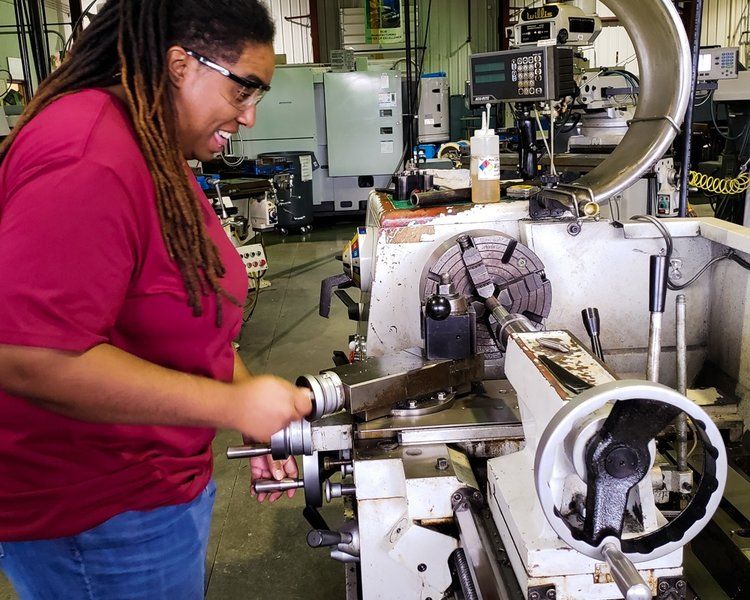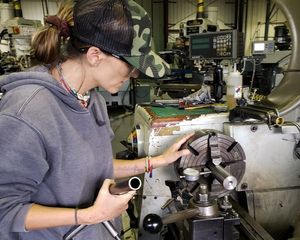Companies can solve their labor shortages by recruiting more women. But can they get (and keep) them on the shop floor?
The manufacturing industry in the U.S. has a problem. Nationally, manufacturing is facing a shortage of skilled labor that is predicted to worsen in the immediate future. The mass exodus of retiring baby-boomers, combined with a workforce lacking the necessary tools and training, and a public that perceives the industry as an undesirable career path are predicted to leave over 2 million manufacturing jobs unfulfilled by 2025.
The good news is that the country has a huge pool of able-bodied, trainable workers eager for steady, well-paying jobs: women, a population that’s historically been ignored by manufacturing recruiters. Despite this, manufacturers have done little to change the way they market to and engage with these potential employees, nor have many companies made moves to change workplace culture in a way that would inspire women interested in going into the field. As it is, women account for only 29% of the manufacturing workforce, despite representing 47% of the workforce as a whole.
On an episode of Scope of Work’s podcast, Danielle Applestone (former Bantam Tools CEO and founder of Daughters of Rosie, an initiative that helps women train for and find entry-level STEM jobs) spoke about the worker shortage as a mixed blessing: “The burn that manufacturers are feeling...is going to allow us to achieve some of the longstanding goals that we have, and one of those is empowerment of women.”
The challenge is figuring out how to connect employers who’ve overlooked women as potential hires with women who’ve traditionally been left out of the usual pathways into the industry. In West Virginia, there’s a first-of-its-kind program that’s working on bridging that gap.
A West Virginia case study
For a place that’s often portrayed in a state of persistent economic distress, West Virginia isn’t doing too bad on the jobs front. But those jobs aren’t in coal, the state’s traditional industry. The fact is, industries like manufacturing, construction, and hospitality have long outstripped mining when it comes to employing West Virginians. In June 2018, manufacturers in the state reported that they were looking to fill over 1,000 positions.
Down here, the coal industry is such an ingrained part of the culture that it continued to inform communal, family, and gender dynamics long after its’ economic power faded. For years, coal allowed West Virginia families to be single-income families: Dad went to work, Mom stayed home. Mining jobs paid enough to afford a comfortable middle-class lifestyle and only required a high-school diploma. The phrase “West Virginia women stay home” was oft repeated, with pride.
So, even as more women were heading outside the home for employment during the latter half of the twentieth century, women in West Virginia were staying home. By 1980, while more than half of women were participating in the workforce nationally, in West Virginia those numbers were much lower, with only 30% of women working outside the home.
Mining families were used to the cyclical boom and bust that was characteristic of the industry, but by the 2000’s it was clear that layoffs were eclipsing hiring at an ever-increasing rate. Families found themselves unable to make ends meet on a single income, while at the same time the number of families headed by single mothers was rapidly increasing. Many women had no choice but to enter the workforce, where they found that most of the jobs available to them were in the so-called pink-collar fields: hospitality, service, retail. Unlike blue-collar positions that came with higher-than-average hourly wages and the perks of union membership, these jobs were often minimum wage, offered no benefits, and burdened families with the added cost of childcare.
There were simply no pathways for women to work in manufacturing. In an industry where most training and apprenticeship opportunities are on the job, you have to get hired to learn the necessary skills, and women were not seen as serious candidates. Employers accepted as gospel the stereotypes of women workers: “Women can’t do physical labor.” They “don’t like to get dirty.” “Women aren’t interested in machinery.”
In 2017, two organizations, WV Women Work and Apprenticeship Works, launched a program to tackle the manpower problem with a program specifically aimed at women: Step Up for Women Advanced Manufacturing Pre-Apprenticeship Program, a tuition-free, women-only training scheme to launch more women into the manufacturing sector.
The ten-week course - the first of its kind - is free of charge and open to all women. Students are trained for entry-level manufacturing positions and on-the-job apprenticeships with classes in blueprint reading and precision measurement, instruction in manual and computer-controlled mills and lathes, OSHA requirements, and soft skills like resume-writing and interviewing. The women also spend time touring area companies and shadowing employees to get an idea of how they could put their new skills to work once they graduate.
Classes are offered in two cities: Huntington and Bridgeport. The former is a city on the Ohio River near the Kentucky and Ohio borders that’s most famous for being an early epicenter of the opioid crisis, while the latter is a town in the northern part of the state that’s recently attracted the attention of the fracking industry. Students range from recent high school graduates to grandmothers. Many have college degrees but have been unable to find positions that pay more than $9-10/hr, while manufacturing jobs in West Virginia commonly start at $14-16/hr. Nearly half are single mothers.
Word of the program has spread organically, mainly through social media and word-of-mouth. A staff that is passionate about the mission don’t hurt either. “Sometimes I’ll even approach women on the street,” says program coordinator Lakeisha Hines, “give’em my card and let them know what we’re doing.” Classes are small, around 20 students per course, and both locations have waitlists for upcoming sessions.
One of the women approached by Hines is Nina Victorin, who was working at a sporting goods retailer when Hines convinced her to apply for the program. In September, she became part of Bridgeport’s second graduating class. “I’d never worked with machines before, but I always liked doing things with my hands, like building,” said Victorin, “So I thought, why not?”
West Virginia Women Work has been around for almost 20 years (they also run an established training program for women in construction), so Hines and her colleagues are well-versed on the challenges of getting women into the labor force in this region. As recently as 2014 the state ranked dead last in the percentage of women participating in the labor force, with less than half (49.3%) of women age 16 and older employed or looking for work. For the program to be a success, they knew they’d have to address the unique barriers facing their students.
Transportation is one of the biggest obstacles for workers in this mountainous rural region, so the program helps pay for the cost of gas. They also help students purchase boots, work clothing, and personal protective equipment. Women have narrower feet and higher arches, so manufacturers must create new molds rather than simply scaling-down a men’s boot. A specialized product for a smaller market means women pay a higher price for work boots and other required on-the-job gear. And while companies often supply their workers with personal protective equipment, what’s on hand is usually too big or bulky for a woman’s frame and employers are generally not inclined to invest in additional gear sized for only one or two workers.
Of course, this would all be for naught if there aren’t any companies willing to hire women, which is why Hines expends a considerable amount of energy reaching out and working with local manufacturers, like the aerospace manufacturers Pratt & Whitney and Bombardier. She’s able to vouch for the students’ reliability and skill level, and hiring managers have the benefit of knowing that the women they hire have already shown a commitment to pursuing a career in the field, are familiar with the equipment and working environment, and have realistic expectations of what the job will be like.
The confidence factor

There was one word that kept coming up again and again in my conversations for this story. Confidence. Everyone seems to agree that building confidence is perhaps the most important factor in increasing the number of women in manufacturing.
The women “are not sure how they will be perceived when they do apply for the job or go in for the interview,” said Hines. “They don’t want to be singled out or treated differently than anyone else employed there. There’s a barrier there with the confidence, and also the employers having the confidence that they can do the work.”
It’s a core component of what Step Up instills in the classroom and is reinforced with mock job interviews and discussion about what issues women may encounter on the shop floor. When asked what the biggest takeaway from her training was, Victorin answered: “Really having confidence. Knowing that I can do more than just a retail job.”
But the onus is on employers to ensure that they can continue to support women once they’re on the shop floor. Their ability to retain these employees will depend on it.
Sexual harassment remains endemic in blue collar jobs. This 2017 New York Times report chronicles women’s stories that range from unwanted touching and sexual advances to deliberate equipment tampering. The industry also boasts one of the largest gender pay gaps. As of 2016, women in production-related manufacturing jobs made about 75% of their male counterparts’ compensation, though the pay overall is much higher than what’s available in traditional pink-collar jobs.
Additionally, both Applestone and Hines pointed out that while the higher wages are attractive, addressing issues like accessible childcare and flexible working hours would go a long way towards attracting women to the shop floor - and keeping them there. The nature of shift work, the predominant scheduling system of most manufacturers, is a major barrier since women still shoulder most of the burden of raising children. Overnight or unpredictable working hours conflict with children’s school schedules and make finding childcare difficult, if not impossible.
West Virginia’s Step Up program graduated its first class in 2016 and, according to WV Women Work, so far they have an 80% placement rate. Feedback from local companies has been enthusiastic. According to program coordinator Lucinda Curry, employers have reported that the graduates they’ve hired are more detail-oriented and better at applying what they’ve learned to their tasks than many male employees. “They, you know, read the directions,” says Curry, laughing.




